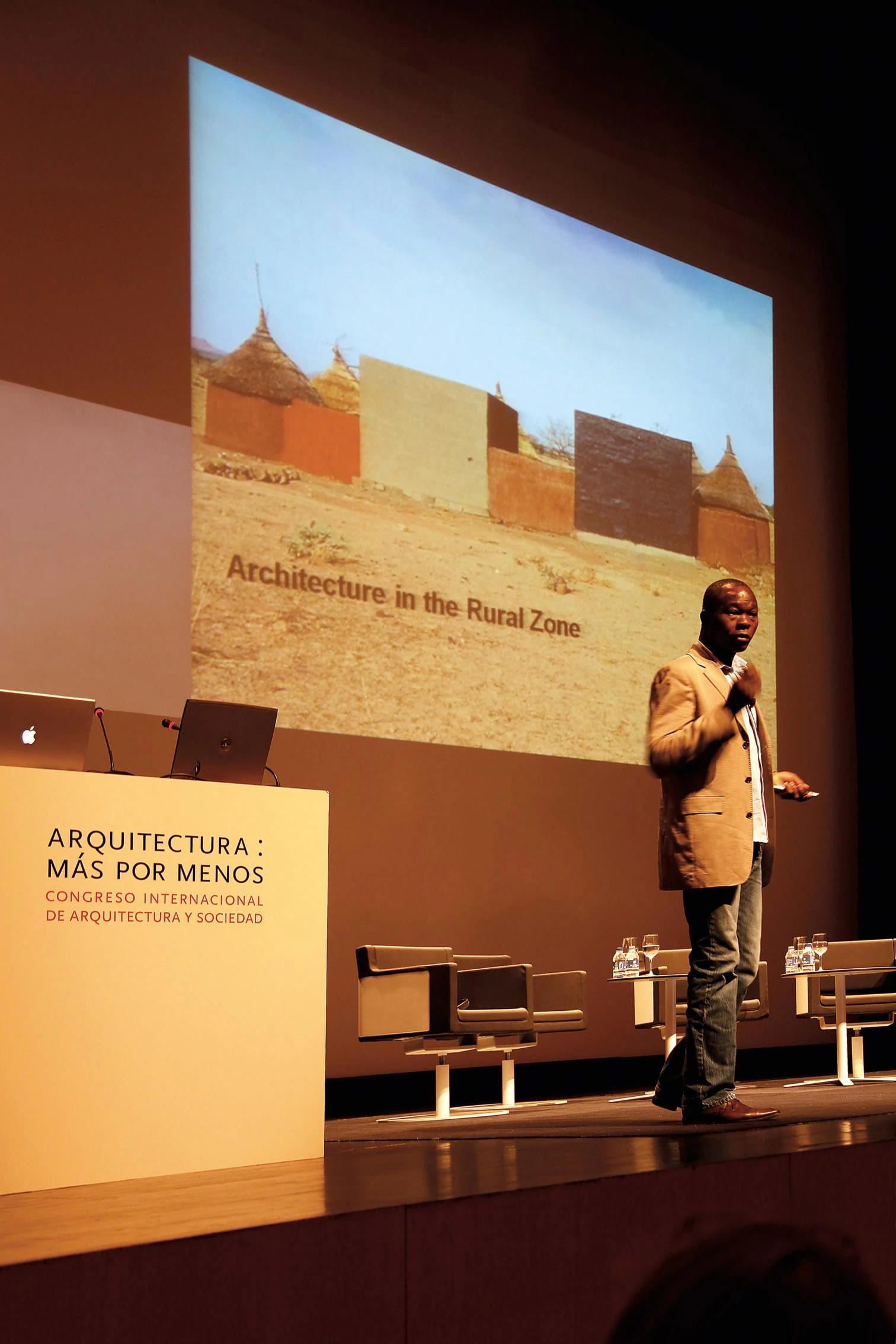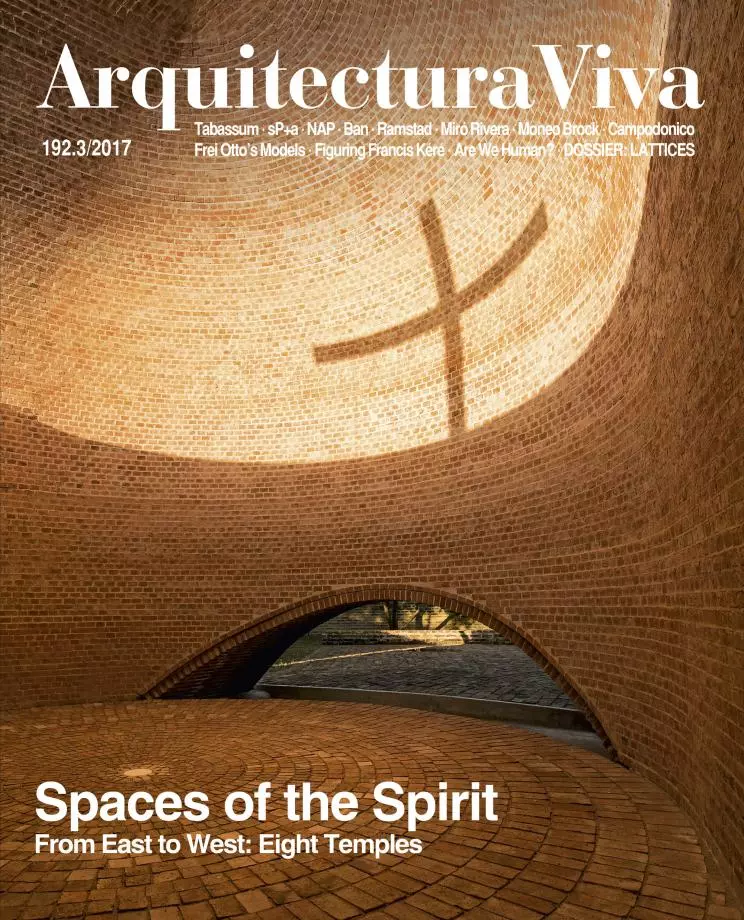
Diébédo Francis Kéré appeared on our screen with the Aga Khan Award in 2004. I wrote about him in El País in December, and the AV Yearbook released shortly after covered prominently the now mythical school in Gando. But he was still a blurry figure, that we could only imagine as a counterpoise to the urbane sophistication of David Adjaye, pigeonholed in the conventional box of ‘African architect.’ In the following decade, through personal contact and better knowledge of the work, his profile became sharper and his stature higher, coming into focus as a charismatic character, endowed with talent and empathy to develop the skills of leadership that he now so evidently shows. What follows is the account of this itinerary of discovery.
When we first invited him to Spain in 2008, to exhibit his work in Expo-Zaragoza and to lecture in Madrid, we still called him ‘Diébédo,’ a name meaning, as we would later learn, ‘he who came to improve things.’ But in the exhibition at the Spanish Pavilion under the title ‘Zaragoza Kyoto: Architectures for a Sustainable Planet,’ he shared the space with, among others, Lacaton & Vassal, and we found that the Casablancaborn Jean-Philippe Vassal, who wa his friend and colleague at the TU Berlin, always called him Francis, the name he would ultimately prefer for his public persona. Now, Francis is also a great name, as the current Pope Bergoglio has made clear, and it resonates wonderfully with the truly Franciscan spirit of Kéré’s architecture, so in the future he would also be Francis for all of us.
After the opening of the exhibition in Zaragoza, Kéré lectured at Madrid’s Reina Sofía Museum, and his performance on the stage was beyond belief: autobiographical and theatrical, banging the platform with this feet to explain the preparation of rammed earth, almost dancing while he evoked the communal building of the primary school in his native village, he brought the audience to a crescendo of emotion. He was sharing the day with figures like the revered Brazilian architect Jaime Lerner, former mayor of Curitiba and a dazzling public speaker, but Kéré captured the hearts and the minds of the house with effortless grace. So when the following year I introduced a lecture of his at Madrid’s Casa Encendida, we all knew what to expect, and he did not disappoint, bringing his passionate commitment and boundless energy to a crowded auditorium.
In 2010 I happened to be a member of the jury for the BSI Swiss Architectural Award, together with the winner of the first edition, Solano Benítez, and MoMA’s curator for architecture, Barry Bergdoll, and it was easy to persuade Mario Botta, the founder of the prize, that Francis Kéré would be a worthy recipient of the distinction. After the Aga Khan, this was the second significant prize, and many others would follow: the Markus in 2011, the Holcim in 2012 or the Schelling in 2014, where Kéré was generous enough to share it with the two runners-up, Anna Heringer and Carla Juaçaba. But the Swiss Award was important because Botta invited Kéré to teach in Mendrisio, became very fond of his can-do enthusiasm, and in the end acted as a mentor for the Berlinbased architect from Burkina Faso.
The ability to establish these empathetic relationships with others had a showcase in the first congress of the Fundación Arquitectura y Sociedad, that we held in Pamplona in June 2010, and where Kéré delivered – or rather performed – one of his impressive lectures, spending three days in the convivial company of colleagues like Renzo Piano, Jacques Herzog, Glenn Murcutt, David Chipperfield or Alejandro Aravena, all of which were seduced by his authenticity and his warmth. It is indeed very difficult to separate in Kéré the socially committed, technically inventive and climatically wise architect from the charismatic, spontaneous and lovable individual, so when we decided to give him the cover of the Arquitectura Viva issue dedicated to the congress, the image chosen – two women dressed in bright colors applying mud with their hands on a wall – tried to express the intertwining of architecture and life in the work of Francis.
By then we had published his work in the congress book and in several issues of our magazine, but I had not yet visited any of his buildings, so in the spring of 2011 I welcomed the invitation of the director of the Aga Khan Trust for Culture, Luis Monreal, to join him on a trip to Mali, where they were restoring the extraordinary earth mosques and had commissioned Kéré several works in Bamako and Mopti. In the capital city I was impressed by the renovation of the National Park of Mali, which included a sadly abandoned zoo, and where Kéré had built the entrance pavilions, a restaurant with a large canopy flying over rocky outcrops and a soberly elegant sports center; but the real excitement of the trip was further north, in the mosques renovated by the Trust in Djenné and Mopti, and in the Center for Earth Architecture built by Kéré in the latter city, with its laconic, regular forms in the shadow of the Great Mosque.
Vernacular and Pragmatic
At the time I was preparing the Africa volume of our Atlas series, and our deep ignorance of the continent prompted me to ask Francis for help; in the end, it was only through the combined knowledge of him and our common friend Farrokh Derakhshani, director of the Aga Khan Award for Architecture, that we managed to bring the project to completion. Two years later, when we presented in Madrid the complete four-volume series, which featured the works of hundreds of architects from all over the world, El País asked me for two contributors who could jointly express the spirit of the endeavor, which had already been warmly praised by critics and historians like Kenneth Frampton or Roberto Segre, and I did not doubt: Norman Foster and Francis Kéré would be the best interpreters of global architecture for the general public, and their articulate, nuanced and moving texts proved it fully.
The paths of the two architects crossed again in Madrid the following year, because we launched an exhibition in the spring of 2014 under the title ‘The Architect is Present’, where Kéré, TYIN, Anupama Kundoo, Solano Benítez and Anna Heringer showed their different approaches and conducted workshops in the gallery space itself, giving visitors the opportunity to interact with the architects. One of those visitors was Norman Foster, who was utterly fascinated with the work of Kéré, exploring ways to collaborate in a conversation where one could easily feel the chemistry flowing. This time Francis spent ten days in Madrid, which gave us the opportunity to organize several lectures and visits, strengthening the links with Spain when his career was becoming so successful that we risked losing him to outer space.
In fact, bringing him in 2016 to lecture at the Valencia School of Architecture on the occasion of the institution’s fiftieth anniversary was extremely difficult, because commissions like the Parliament of his country – burnt down during the revolution of 2014, Kéré presented the project in the last Venice Architecture Biennale, a transparent planted ziggurat that will go up in the center of Ouagadougou inviting citizens to enjoy its stepped terraces – have turned his agenda into a complex puzzle of official meetings, commitments, and travel.
But in spite of the explosion of projects, prizes and commitments, Kéré remains faithful to his village of Gando, to Burkina Faso and to his friends. It is of course wonderful to see him working for the Obama relatives in Kenya, protecting the Royal Baths in Sudan or designing a pavilion for the Royal Academy in London; however, his most moving work is still to be found close to his roots. When we try to figure out Francis, the image of the Gando school – with its magnificent hybridation of vernacular building techniques and German fact-based knowhow at the service of a worthy cause – is the first that comes to mind. And Francis Kéré himself is happy combination of African character and European experience, an architect and a person like few others, having intertwined his professional itinerary and the welfare of his community to a point where both can no longer be distinguished: this is his humility and his greatness.





